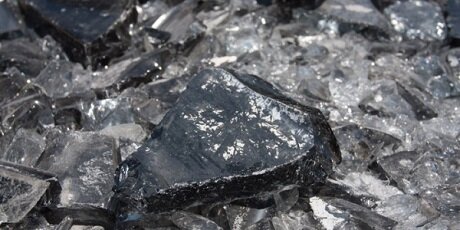
Q&A with our CRT Glass Source, ECS Refining
The following blog post comes from a Q&A Session between Fireclay Tile, a San Jose tile manufacturer using recycled CRT glass to make kitchen and bathroom tiles, and ECS Refining Marketing Manager, Mark Van Elderen. This post covers what ECS Refining is all about, the issues surrounding CRT glass, and how this difficult material stream is being recycled.
"Hi Mark! First of all, tell me about ECS Refining"
Mark – "ECS Refining is a downstream electronics recycling and IT asset disposition firm that provides compliant recycling and reuse solutions for a wide range of electronic devices. Customers rely on ECS to responsibly recycle their e-waste and securely manage the sensitive data that comes with it.
ECS Refining was founded in 1980 in Santa Clara, CA by Jim and Ken Taggart. Originally, ECS specialized in recovering precious metals from post-manufacturing scrap and residues from the computer manufacturing industry. As the electronics industry enjoyed rapid growth and manufacturing operations were outsourced to other parts of the world, ECS Refining adapted by shifting its focus to recycling post-consumer electronics, or what many people refer to as electronic waste or e-waste. This includes computers, laptops, printers, phones, networking equipment, flat screen TV’s and monitors, and yes—CRTs.
From the beginning, ECS Refining’s mission has been to provide responsible recycling solutions that recover reusable resources in a manner that protects workers and the environment. As an e-Stewards Certified recycler, ECS adheres to a strict “no landfill, no export” policy by recycling 100% of the material we receive at our state-of-the-art domestic recycling facilities."
"What is a CRT device?"
Mark – "The CRT has been the primary display technology used in televisions and monitors for the past 80 years. Think of the bulky, old style TV’s and monitors with the thick glass screens – they all contain a CRT or cathode ray tube. The screens that we are accustomed to staring into are the front end or faceplate of the tube."
"What is in a CRT device?"
Mark – "Essentially, a CRT device is made up of a glass vacuum tube with three electron guns that deflect electron beams onto a screen to create images. The glass vacuum tube consists of three different types of glass: the panel, the funnel, and the frit. The different types of glass come into play in the recycling process, so I’ll come back to that later. The CRT tube is also usually housed in a plastic (or sometimes wood) casing which also contains a steel frame, a printed circuit board, a copper yoke and wiring."
"Why are CRTs being replaced by flat screens?"
Mark – "CRTs have become an obsolete technology over the past decade, replaced by flat panel displays (such as LCDs) which are lighter, thinner, more energy efficient, and have higher picture quality. In addition, advances in technology have allowed prices of flat panel displays to fall significantly over the past 5-7 years. That is why we’re seeing CRT televisions and monitors entering the waste and recycling stream on a massive scale."
"Why is the CRT crisis getting so much attention now when these devices have been a part of the electronic waste stream for decades?"
Mark – "The CRT crisis has been exacerbated by the fact that traditional downstream markets for CRT glass have either dissipated or changed significantly.
Historically, one of the most reliable downstream solutions for CRT glass has been glass-to-glass recycling, a process by which CRT glass is recycled to manufacture new CRTs. But with the demand for new CRT televisions and monitors plummeting, industry experts are predicting that it will no longer be a viable option within the next few years. Today, there is only one glass-to-glass CRT processor, and the cost of doing business with them has increased significantly.
Another downstream solution that has diminished in recent years is lead smelting. The CRT glass can be melted in a lead furnace and the lead can be extracted and sold as a commodity. However, due to an abundance of other secondary feedstocks (other sources of lead-bearing material streams) there are only a few lead smelters that are accepting CRT glass and their capacity does not meet the recycling industry’s high-volume demands.
As a result, many recyclers are irresponsibly stockpiling CRT glass in massive quantities, either because they don’t have access to the current viable downstreams or because they are hoping for a more cost-effective solution to present itself. An industry report produced by Transparent Planet estimates that 660 million pounds of CRT glass are being stored at locations throughout the US."
"Where do you get most of your CRT waste?"
Mark – "ECS serves as an e-waste recycler for companies like consumer electronics manufacturers as well as IT departments of Fortune 2000 enterprises. Our best customers are enterprises who are committed to environmental sustainability. ECS also serves as the downstream recycler for non-profits, environmental service providers, waste haulers, landfills, and other recycling companies who provide convenient e-waste collection services to the public."
"What is the ECS process for recycling CRTs?"
Mark – "Recycling CRTs is probably the most unique process within our operations because we don’t utilize a shredding system.
First, we manually remove the plastic shell of the CRT monitor or TV. Next, we release the vacuum by removing the electron gun, copper yoke and wiring. ECS utilizes multiple downstreams for the remaining glass tube that require different preparation processes. For downstreams that require clean, lead-free glass, a proprietary separation technique is applied to liberate the 'panel' from the leaded 'funnel' and 'frit.'"
"Can you please touch on the different steps taken by ECS to clean the CRT?"
Mark – "ECS sends only separated and cleaned “panel” glass to Fireclay that complies with the Department of Toxic Substance Control’s (DTSC) requirements.
After the 'funnel' is removed from the tube, the phosphor powder that coats the inside of the tube is vacuumed off. Next, the tube is put through a proprietary separation mechanism that removes the 'frit' from the 'panel'. Then, the panel goes through a series of inspections to verify that it has been completely liberated from the leaded glass fractions. Finally, the clean panel glass is crushed, boxed, and shipped to Fireclay. The remaining leaded glass is shipped to the other downstream processors mentioned above.
This process is remarkable because our separation and cleaning process is capable of effectively and efficiently producing a product that is safe to use for a wide variety of applications."
"What will happen if we do nothing about CRTs?"
Mark – "If the recycling industry isn’t willing or able to develop and invest new technologies and processes for recycling CRT glass, this material stream could end up in landfills as a wasted resource contaminating the environment.
The bottom line is that it’s important for companies like ECS and Fireclay to work through these challenges to develop sustainable, beneficial applications for CRT glass. ECS is thrilled to have a partner whose goals are aligned with ours and we look forward to supporting this initiative moving forward."
Publication Date: 12/11/2013
